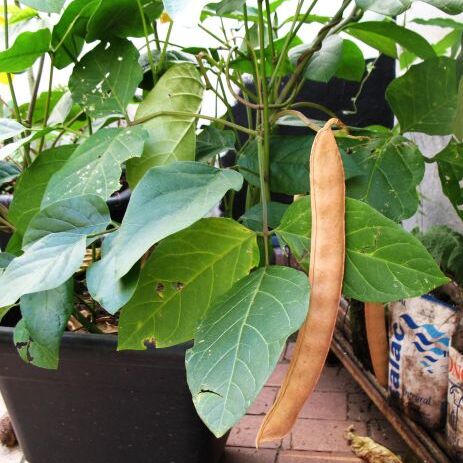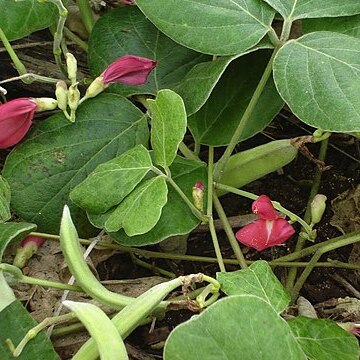Woody lianes or perennial herbs, a few species cultivated as annuals. Stems trailing or climbing. Leaves pinnately 3-foliolate; stipules small, deciduous, sometimes spurred and swollen below; stipels small, deciduous. Inflorescences axillary, racemose, or flowers paired or in small groups along the rhachis which is thickened at their point of insertion. Flowers mostly large, often rather thick in texture, white to purple. Calyx 5-lobed, 2-lipped, the lower 3 lobes joined to form a trifid or entire lip, upper pair joined to form a bifid or truncate lip. Standard rounded, reflexed, sometimes auriculate, appendaged; keel incurved, obtuse or beaked, often twisted. Stamens generally all joined, the vexillary one free only near its base, rarely quite free; anthers uniform. Ovary usually many-ovuled; style slender, curved, glabrous; stigma small, terminal. Pods linear or oblong, (1–)4–15-seeded, flattened or turgid, often winged or ribbed along the upper suture and sometimes with additional ribs, sometimes thinly filled between the seeds; endocarp papery. Seeds ovoid, ellipsoid or reniform, compressed; hilum linear, mostly at least half as long as the seed; a small papery persistent extension of the rim-aril present.
Herbs, annual or perennial. Stems twining, prostrate, or suberect. Leaves pinnately 3-foliolate; stipules small, wartlike or inconspicuous; stipels present, deciduous. Racemes axillary; bracts and bracteoles minute, deciduous. Flowers purple-violet, rose, or whitish, solitary or 2-6 clustered at swollen nodes. Calyx campanulate, 2-lipped, upper lip larger, truncate or 2-lobed, lower lip small or minute, entire or 3-toothed. Corolla longer than calyx; petals shortly clawed; standard large, suborbicular, reflexed; wings narrow, falcate, sometimes slightly twisted, free; keel broader than wings, incurved, obtuse or beaked, beak inflexed or spirally twisted, shorter than standard. Stamens monadelphous; anthers uniform. Ovary shortly stipitate, many ovuled; style incurved, beardless. Legumes large, ligulate or linear-oblong to oblong, compressed or slightly turgid, with prominent rib along ventral suture and extra ribs parallel and close to it, dehiscent by twisting of valves. Seeds 10-15, elliptic or oblong; hilum linear.
Fls in axillary racemes, calyx 2-lipped, standard reflexed, stamens monadelphous. Ovary stipitate, ovules ∞, style filiform, beardless; stigma terminal. Pods large, about oblong, 2-valved, valves ridged. Hilum linear. About 30, mainly tropical, spp. of erect or trailing herbs. The N.Z. sp. is widespread in the tropics.
Pod linear or oblong, flattened or turgid, often winged or ribbed along the upper suture and sometimes with additional ribs, sometimes thinly filled between the seeds; endocarp papery, (1)4–15-seeded.
Seeds ovoid, ellipsoid or reniform, compressed; hilum linear, usually at least half as long as the seed; hilum with a small papery persistent extension of the rim aril.
Corolla white to purple; standard rounded, reflexed, sometimes auricled, appendaged; keel incurved, obtuse or beaked, often twisted.
Calyx 2-lipped; upper 2 lobes joined to form a bifid or truncate lip, the 3 lower ones joined to form a trifid or entire lip.
Leaves pinnately 3-foliolate; stipules small, deciduous, sometimes spurred and swollen below; stipels small, deciduous.
Flowers in axillary racemes or pseudoracemes with 2–several at swollen nodes, often rather large and thick in texture.
Stamens all joined, the vexillary one free only near its base, rarely quite free; anthers uniform.
Woody lianes or perennial herbs, a few species cultivated as annuals; stems trailing or climbing.
Ovary usually many-ovuled; style slender, curved, glabrous; stigma small, terminal.


